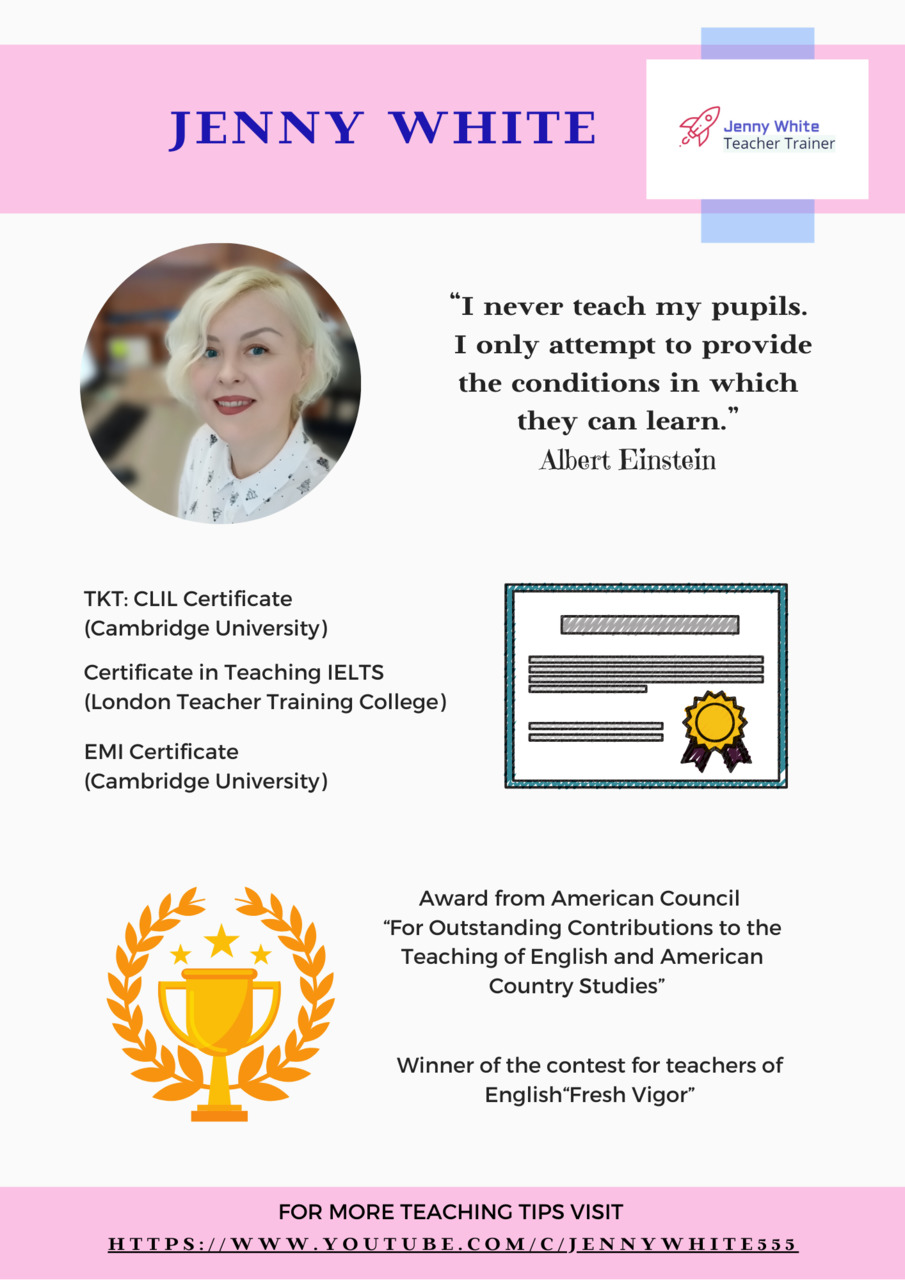
Бесплатный фрагмент - Teach Without Stress
Great Lessons Without Great Efforts
Meet the author

How can this book help you
Dear Reader,
Do you want to be a perfect teacher that would meet all the needs of your students and requirements of the school administration? I am sure you do. But perfection is hard to achieve. If you put too much effort into your work, you will soon burn out. This is a dead end. But there is another solution.
This book will give you “cheat codes” for being a GREAT teacher WITHOUT great efforts. You will learn how to make your teaching life more relaxed by using easy paths, tips, and shortcuts that I have learned in 20 years of teaching so that your students could achieve brilliant results.
The book contains 40 teaching tips for 10 aspects of teaching, including lesson planning, classroom management, dealing with misbehavior and many others. Each aspect corresponds to one of the ten months in a school year. There are 4 tips in a month, one for every week. So this book can be used as a weekly planner.
The best thing about the book is this “in-the-flow feeling” that you will experience every day if you put the tips into practice. Your relationship with students will be taken to a really different level, where there is trust, creativity and joy. You will never run out of ideas and your students will never get bored.
Turn the page and make the first step into a new life!
Yours,
Jenny White
September. Getting to Know One Another
“You never get a second chance to make a first impression”
Oscar Wilde
First impressions set the tone for the future relationship. They break or build barriers that will be difficult to overcome later. They create unwritten laws and rules that will facilitate or slow down the learning process. That is why the first lesson is so important.
In this chapter you will learn:
• how to capture students’ attention in the first minutes of the lesson
• how to facilitate the process of making new friends

Week 1: Find the leader — Look for biggest cluster
“Engage the leader, and the leader will engage everyone”. On coming into the classroom for the first time, you may see the following picture: students are scattered around the classroom in groups or pairs, or even sitting alone. Look for the biggest cluster. The leader is always surrounded by numerous supporters. Come to this group and start talking to them first. The leader will be the first to answer your questions. Talk to the leader. All the other students will listen to you and join in.
Week 2: Nice to meet “new you”
Put a colorful paper feather into your hair like an Indian and write on the board your new name according to this model: name + the + adjective + noun. For example, “Billy The Black Wolf”. Explain your choice: “I chose ‘wolf’ because I am lonely and strong. Black is my favourite colour”.
Invite your students to introduce themselves with new names and explain their choice. Call them by these names during the whole lesson. You can start every lesson with asking how they feel: “Are you still the Black Wolf today?” — “No, I am a Flying Dragon because…”
Week 3: Friendship Snow Ball
Students introduce themselves and add one fact about their life. Every next student should first repeat the information and only then add a fact about his or her life. “This is my new friend Laura and she likes sausages. This is my new friend Paul and he can skate. This is my new friend Lucy and she’s got 5 sisters. And this is me, Mike, I am from Portugal”. In large classes you can first show how to play in a small group of students, and next all students will play in groups of 5—6.
Week 4: Box of Likes/Dislikes
Write on small pieces of paper something that people like or dislike: boiled onion, singing in the shower, playing computer games etc. Try to include something funny, something strange and really popular things. Put the cards into a box. Students one by one should take out a card and say if they like what is written on it or no. When they finish, check their memory. Read the cards one by one and students should say who spoke about this card and what he or she said.
October. Classroom Management
“I never teach my pupils. I only attempt to provide the conditions in which they can learn.”
Albert Einstein
Classroom management is an aspect of teaching that implies multitasking. A teacher should be a manager, a policeman, a coach, an actor and what not. The aim of it is to make the process of learning go smoothly without interruption.
In this chapter you will find some pieces of advice that will:
• help your students to “cool down” when necessary
• prevent disruption caused by the unsuitable seating plan
• adjust desks arrangements to the type of the lesson
• offer various types of praise according to the difficulty of the question

Week 1: Different Degrees of Praising
The way you praise your students can work wonders! But your reaction should be equivalent to the level of difficulty of the question you asked. Various degrees of praise, both verbal and non-verbal, will help students understand how well they work. For easy questions you can just say a typical “Well done!”. For a correct and funny answer, you can wink and show thumbs up. If the answer is excellent, you can even come to this student and shake hands. Use stickers, applause, give high-fives, draw stars on the board!
Week 2: Seating Arrangements
Students are often very sensitive when it comes to seating arrangements. They may want to sit only with their friends or alone, or near the board, or far away from the board. In order to prevent arguments, explain that everybody will change seats every month because it is good to work with different partners. Say: “The number of your seat for this month is inside this box”. Students should take out a number out of the box and sit at the desk under this number. It looks like a lottery and no one usually objects.
Week 3: “Put Your Hands Down…” (cool-down technique)
After the break students can get too excited. This transition chant will help them switch from fun to studies. While they are still standing, say loudly and use body gestures (make sure students do them too):
“Put your ha-a-a-aands (put your hands up and hold them) down (put them down quickly), hold your he-e-e-ead (touch your chin) up (raise it), slowly sit down, don’t stand up (hands crossed). Put your ha-a-a-nds on the desk (tap tap). Put your fe-e-eet on the floor (stomp stomp). Keep your back straight (straighten your back) and say: “Hello!” (wave your hands). Make a pause after every word in bold and let students finish with the words in italics.
Week 4: Change Desks Arrangement
Some teachers keep the same desks arrangement throughout the academic year. Don’t be afraid to experiment with different seating arrangements. Surprise your students by changing the way your classroom looks like.
Arrange the desks according to the main type of activity in this lesson. For group work and projects put desks in small circles, for class discussions a semicircle of chairs would be most suitable. Rows and lines of desks with some space between them are great for tests. You can even put the desks to the walls and sit down on the floor in the center!
November. Motivation and Engagement
“The greatest sign of success for a teacher is to be able to say: “The children are now working as if I didn’t exist”.
Maria Montessori
Motivation and engagement always come before learning. Students will not learn anything unless they feel motivated and get engaged.
So, in this chapter you will learn:
Бесплатный фрагмент закончился.
Купите книгу, чтобы продолжить чтение.